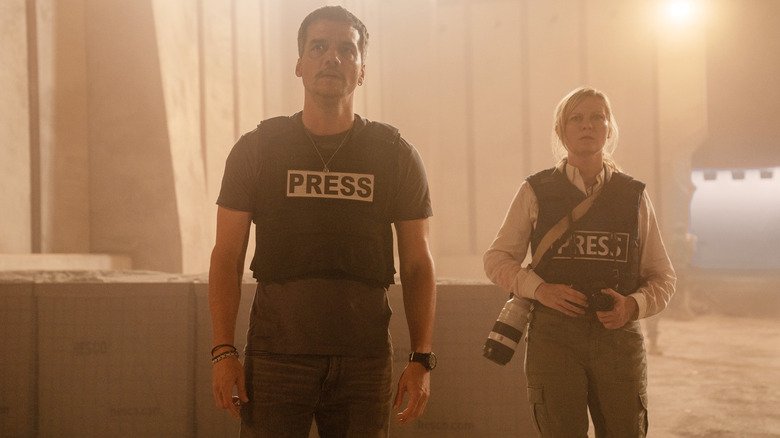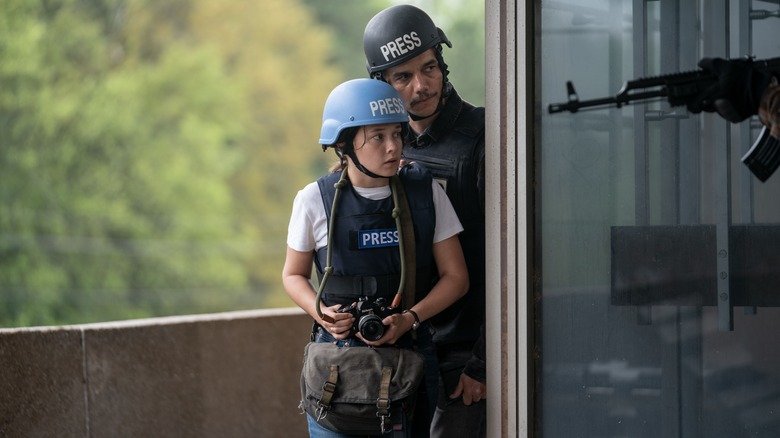Civil War Hired Real-Life Soldiers For The Movie's Biggest Action Scene
When interviewed by the Chicago Tribune in 1973, the critic and trailblazing French New Wave actor/filmmaker Francois Truffaut famously stated that he'd yet to see a truly "antiwar" movie, adding, "Every film about war ends up being pro-war." His argument, in essence, was that the very act of making war cinematic tends to infuse it with qualities that make it more entertaining and, as a result, less horrifying. In contrast to that, Truffaut's "Close Encounters of the Third Kind" director Steven Spielberg — then on the heels of helming his WWII drama "Saving Private Ryan" — once told Newsweek that "every war movie, good or bad, is an antiwar movie." In his case, Spielberg reasoned that by portraying warfare as convincingly as plausible, it becomes impossible for a film to be pro-war since war is, itself, an inherently horrific thing.
If there's a middle ground between these two camps of thought, it's the same sweet spot that "Ex Machina" and "Annihilation" director Alex Garland appears to be reaching for with his new movie, "Civil War." A speculative work that follows journalists documenting a second U.S. Civil War in the foreseeable future, Garland's film aims to split the difference by depicting war without romanticizing it. This goal manifests itself in every aspect of the movie, from strange music choices that are designed to have a jarring and discomforting effect when juxtaposed with the film's action scenes to its use of actual soldiers during its biggest and most intense sequence (which we won't spoil here).
Speaking to ScreenRant, Garland explained that he collaborated with former Navy SEAL Ray Mendoza to bring a heightened sense of verisimilitude to the film's combat scenes. With that objective in mind, Garland encouraged Dose to move through the chaos much as he would if it were happening for real.
Recording the journalists recording the soldiers
Watching documentaries like "Bobi Wine: The People's President" and the Oscar-winning "20 Days in Mariupol," it's near-impossible to forget that the people who made them risked life and limb to record the footage you're seeing thanks to the up-close-and-personal camerawork. But more than that, it's the blatantly unrehearsed nature of the violent events transpiring onscreen in these movies that really terrifies you and leaves you unsettled (as it should). So, when it came time to shoot the biggest action scene in "Civil War," Garland trusted Dose to know what he was doing and built the rest of the sequence around him. In the filmmaker's own words:
"What I said to Ray in the sequence that you are referring to was, 'How would a group of SEALs move from this position to that position? How would they get there?' They've got people shooting at them trying to stop them. That was the only input I had into that. He brought in some colleagues he served with, and they did their thing. And then what we did was function. I said, 'Don't worry about the camera, don't even think about the camera. Don't even think about the actors playing journalists. The journalists will then do what they're supposed to do, which is record what you guys are doing. And then, as the crew, we will record the journalists recording you guys.'"
This journalistic ethos carries over to the rest of the film, which /Film's Jacob Hall described in his "Civil War" review as being "less about the politics of right now, and more about the horror that accompanies a world beyond politics, where all meaning gets lost in gunfire and smoke." It certainly sounds like the feel-bad movie of the year, so much so that one could even imagine the late Truffaut nodding his head in approval.
"Civil War" opens in theaters on April 12, 2024.

